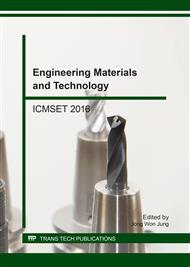p.59
p.64
p.70
p.77
p.83
p.90
p.95
p.101
p.107
Modelling Kerf Width in WEDM Titanium Alloy Using Response Surface Methodology
Abstract:
Wire electrical discharge machining is a material removal process of electrically conductive materials by the thermo-electric source of energy. This kind of machining extensively used in machining of materials with highly precision productivity. This work presents the machining of titanium alloy (TI-6AL-4V) using wire electro-discharge machining with brass wire diameter 0.5mm.The objective of this work is to study the influence of three machining parameters namely peak current, pulse off time and wire tension to kerf width followed by suggesting the best operating parameters towards good machining characteristics. A full factorial experimental design was used with variation of peak current, feed rate and wire tension, with results evaluated using analysis of variance techniques (ANOVA). The test array was further extended to allow for the implementation of Response Surface Methodology (RSM) analysis in order to develop first and second order models for the prediction of kerf width response. The results showed that average percentage error between the predicted and experimental value for kerf width models was less than 2%.
Info:
Periodical:
Pages:
83-89
Citation:
Online since:
June 2017
Keywords:
Price:
Сopyright:
© 2017 Trans Tech Publications Ltd. All Rights Reserved
Share:
Citation:


